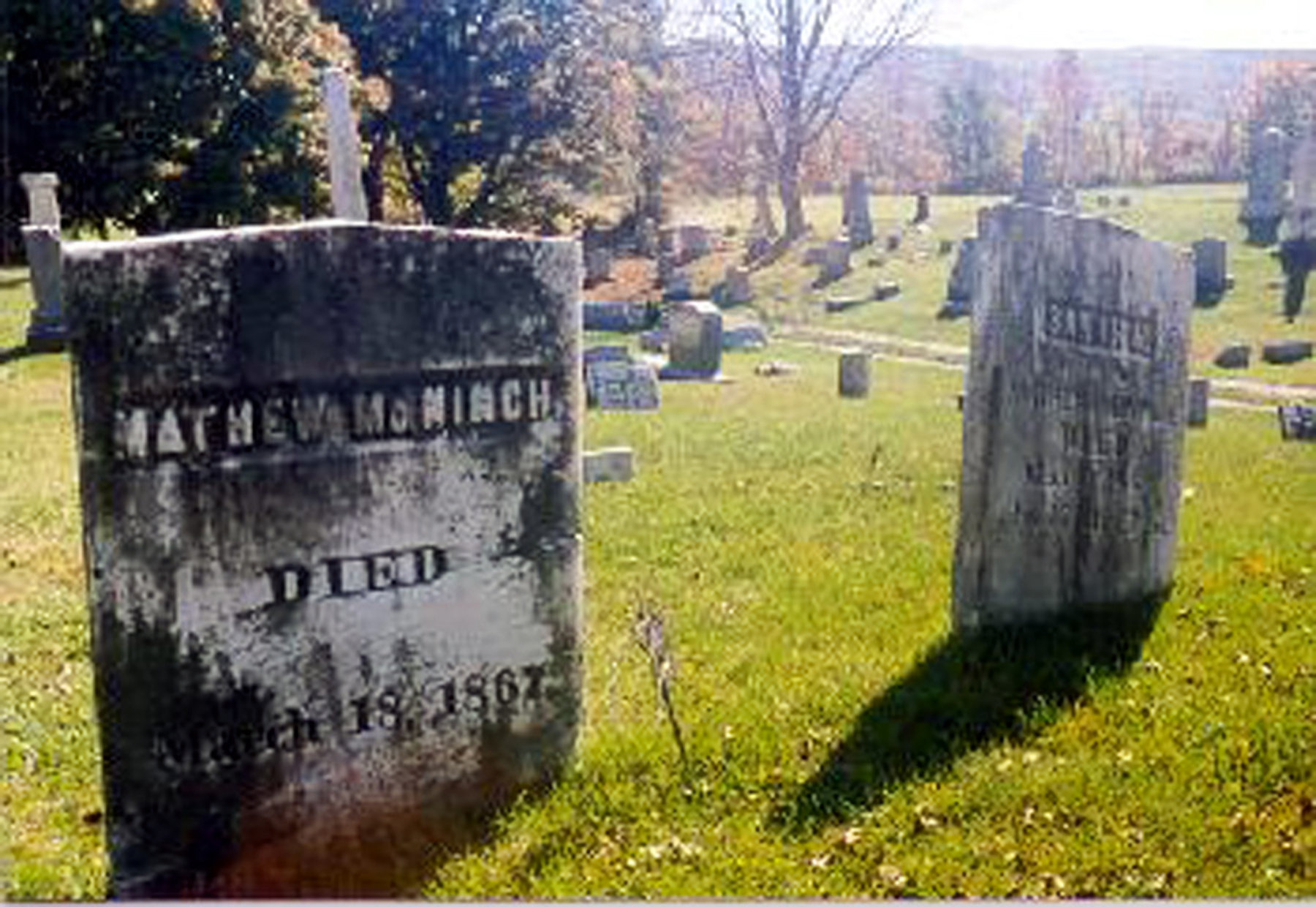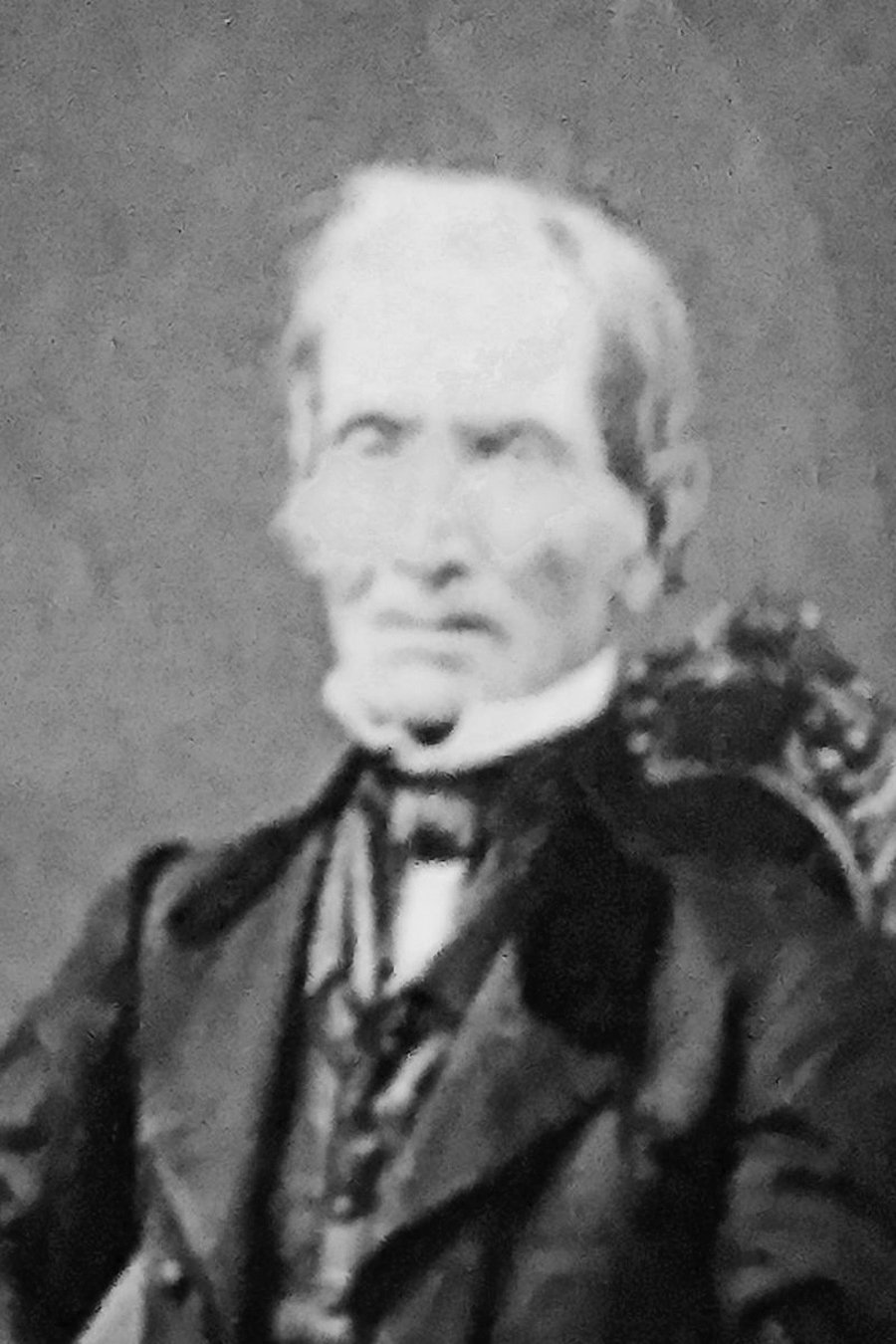Matthew McNinch
- Born: 3 Mar 1784, Sussex County, New Jersey
- Marriage (1): Sarah Coller on 23 Feb 1816 in Conesus, New York
- Died: 18 Mar 1867 at age 83
- Buried: Union Society graveyard in the SW part of Conesus, Livingston County, N.Y.

 General Notes: General Notes:
Matthew moved to Conesus, New York in 1806 and settled in the southwest corner of the town. They moved from Pennsylvania. This information was found in "The History of Conesus 1793 to 1887" by William Boyd printed 1887.
He fought in the War of 1812.
Matthew McNinch's gravestone reads:
Mathew McNinch
died
March 18, 1867
Aged 83 Yrs
& 15 ds.
(War of 1812)
Matthew McNinch, son of Patrick McNinch
McAninch Family History NL, VIII-4 October 2000 Frank McAninch
Matthew McNinch, "son of Patrick McNinch, was born in New Jersey, in the County of Sussucks (Sussex County) in the year 1784, March 3rd, at the end of the Revolution war. He moved that same year up to the state of Pennsylvania, in Northumberland County, in the forks of the Susquehanna. My father's name was Pattrick McNinch, he came from Ireland, was born there. My mother's name was Jane Scott, she came from Ireland also; her father's name was James Scott. My father and mother were married about the year 1770 or 1771. They were in Ireland when married and soon after embarked for North America. They first settled in New Jersey, then after the war, when the Indians got quiet, they moved up to Pennsylvania in Northumberland County, Torbut Township. We resided there until I was about eighteen years old, then my father thought to try and better himself. He had six sons and two daughters, of which two were younger than myself. We fixed for moving to the Genessee country. We got about ready to move, my father got sick, and, it getting late in the fall, he urged the family to start and leave him at his daughter's. They started, and the second day after, he died. We went on, when we got to the wilderness, it came a great rain, raised the water, made bad roads, and we worked our way through to the headwaters of Tioga, went down that to the mouth, then up Canisteo to the head, and not a bridge on either stream. We had to ford it, sometimes the water so high it about swim the horses and waggon. So, we were over the worst of the waters; we worked our way on to Dansville (New York), there was one grist mill, David Shutts, one store, one publick house and a few scattering huts over the plane.
There were but few roads here then, and they were poor and rough. We started from Dansville for the head of Conesus lake. We came by the way of Darling Havens. Mr. Havens, he kept a publick house. Then we went on up to where Jacob Been now lives. We went on through the woods down to where Hector McKay was just making a beginning. He put us on an old road or rather an Indian path down to the inlet bridge, an old log bridge that I expect Colonel Sulivan built to get his army across. Then we were to the head of Conesus lake, on Henderson flats, where we resided for three years. There were but three families of us white folks at the head of the lake. My mother and her family, Mr. Jacob Durham and his family, Mr. [Benjamin] Himes and his family. Except us three families we had no white neighbors nigher than three miles of us, but Indians plenty; they were civil and friendly. This was a great place for fishing & hunting, wild game plenty; I recollect one time in particular, it was on Sunday evening, there was about thirty Indians out before the door, some twenty rods from the house, along the creek, fishing and sporting, hopping, jumping, running and hooping. Hearing so much about those savages in the time of war, I just thought to myself, at that time, if they thought proper at that time, how easy they could have slaughtered us few whites then. But I was not alarmed, nor afraid, for they were peaceable and friendly. They used to fish and hunt, for a number of years after I came here; a few years after that, some two or three years, the white people began to settle in considerably; but in the first place, when I came here, it was a dense wilderness from the head of Conesus lake to Hemlock lake, and on to Naples, and so on. There was not a stick cut in all that distance except what the Indians cut. We went from Conesus to Hemlock valley, now called Springwater, to raise the first house that was built there. That, I think, was in the year of 1805. Then the people began to settle in, the Indians did not like that so well. Just after that, at the end of sugar making, they went through their camps and split up all their troughs, and then fled to their towns on Genessee River, though, after that, they came back to hunt in the fall. It was a great place for game. Sometime after that, we moved from the head of the lake up on the hill about a mile and a half east of the inlet, begun a new place in the woods. The May following, the cattle began to get their living in the woods. … My brother-in-law Joseph Allen lived a half a mile off. …
I recollect another Deer hunt, I went out in the woods one afternoon, just after a rain, the wind blew a considerable gale. I went about half a mile, the first I seen was a large buck, coming quartering towards me. I blasted out, he whirled about, the sapling timber being so thick I could see nothing but his hip. I fired away and broke his thigh. I loaded my rifle, he went off on three legs with great force. I followed him by the blood for some distance, it was getting towards night, I went home. Next morning, came back with Joseph Allen and two dogs, we went to the place I left him night before, and started out. The dogs, they ran but a short distance till they came upon where he lay behind a log; they ran him about half a mile, and he got behind a dog, and gave battle. He fit the dogs, and got one of them between his horns up against a log, and stopped and pushed him until I shot him again; we got him down and that finished that hunt. We concluded by ourselves, had we not been there he would have killed both dogs.
I have had a great many little frolicks through the woods, with wild game such as bear and deer, and other smaller animals, so it went on. In a few years, after people began to settle in considerably, then the wild animals began to decrease a little; so it went on, till bye and bye the 1812 war began. General Bradsworth was our commanding officer, Captain Levi Dun was our captain. The were a good many drafts, such a number out of every company. Often times there was a company of Volunteers started, and very often, before they got to the lines, got word to return home again. The last draft that was made in Captain Dun's company was made in August 1814; the war ended in 1815. Then we were not troubled; every man was his own man. Then I began to think I could better myself by getting me a companion. I was almost 30 years of age. On February 23rd, 1816, I got married to Sarah Coller, who was twenty-two years of age. Her father's name was Thomas Coller, who died October 28th, 1839. He was buried in the Union Society grave yard lying in the S-W part of the town of Conesus; and his wife's name was Lucerna, who died July 9th, 1848, who was buried in the same graveyard.
I made my permanent residence in the town of Conesus, about two miles south of head of the Conesus lake, on the west side of inlet, where I now live, and have ever since I was married. I am the oldest resident now living in the town of Conesus. I have lived in this town almost fifty-seven years. As to my family, my wife and I have had six children, of whom three are dead, and three are living. As to publick offices, in the year 1821, I was elected for Justice of Peace in the County of Ontario. Not long after that, the counties were divided, Livingston being set off. I was out of office, and glad was I. I found it was more loss than profit for me at that time. Being lone-handed at that time, some thought I had better take the office again, but I declined. I thought I could do better without it. As for our town officers, before the County was divided, it was then the town of Sparta. The chief town officers were Wm. McCartney, Esq., for supervisor, and David McNair, Esq., for town clerk, for many years.

 Noted events in his life were: Noted events in his life were:

1. Picture: Matthew and Sarah McNinch gravestones: Union Society graveyard in Conesus, Livingston County, N.Y.

Matthew married Sarah Coller, daughter of Thomas Coller and Lucina Brace, on 23 Feb 1816 in Conesus, New York. (Sarah Coller was born on 3 Feb 1792 in New Jersey, died on 11 May 1863 and was buried in Union Society graveyard in the SW part of Conesus, Livingston County, N.Y..)
|


 General Notes:
General Notes: